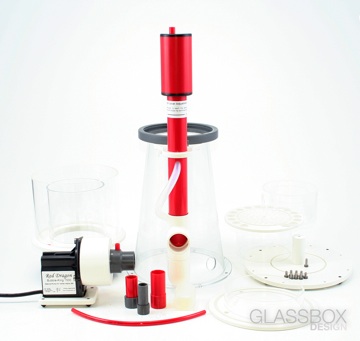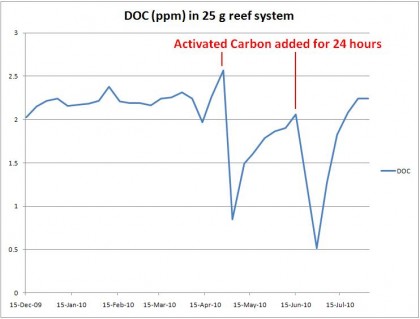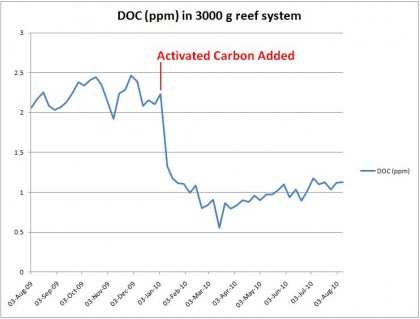Found this and thought it may be of interest. It has me thinking I toss my carbon to quickly.
The Influence of Aquarium Filtration on DOC, Seen with UV 254 Analysis
Editors Note lease welcome Matt Wandell to Glassbox. Matt works as an Aquatic Biologist at the Steinhart Aquarium where he is responsible for many exhibits including this striking Deepwater Reef. Matt is an extremely knowledgeable biologist and aquarists and we thank him for this piece on Dissolved Organic Carbon. One of the most exciting developments in reef […]
lease welcome Matt Wandell to Glassbox. Matt works as an Aquatic Biologist at the Steinhart Aquarium where he is responsible for many exhibits including this striking Deepwater Reef. Matt is an extremely knowledgeable biologist and aquarists and we thank him for this piece on Dissolved Organic Carbon. One of the most exciting developments in reef […]
Editors Note:Please welcome Matt Wandell to Glassbox. Matt works as an Aquatic Biologist at the Steinhart Aquarium where he is responsible for many exhibits including this striking Deepwater Reef. Matt is an extremely knowledgeable biologist and aquarists and we thank him for this piece on Dissolved Organic Carbon.

One of the most exciting developments in reef aquarium science in recent years is Dr. Ken Feldman’s ongoing work concerning dissolved organic carbon (DOC) content in aquariums, as featured in a series of articles in Advanced Aquarist Online Magazine. While most of us employ some type of filtration (protein skimmer, granular activated carbon, ozone) to control the organic carbon level in our aquariums, almost none of us are aware what effects these filtration strategies have on the actual DOC level present. How much does the level of DOC change over time in an aquarium, and why? How does the DOC level change as we apply different filtration strategies to our aquariums? Most importantly, is the DOC level in an aquarium an important parameter to monitor and control, i.e. is there a “target” DOC level for healthy coral growth like there is for salinity, calcium, phosphate, and all the other major chemical parameters of concern?
With some of these questions in mind we recently decided to pursue measurements of DOC in select coral exhibits at the Steinhart Aquarium, California Academy of Sciences. Our method of choice for the following DOC data is seawater absorption of UV light at a wavelength of 254 nanometers. The advantage to this method is that it can be done very quickly and cheaply with a relatively affordable UV spectrophotometer. In short, we shine UV light through a sample of seawater and certain types of organic carbon molecules absorb that light. When we compare the amount of UV light that passes through the sample we can get an estimate of the total DOC in the sample.
Dr. Feldman and Dr. Craig Bingman have pointed out to us that this method is at best a very rough approximation of the exact value of DOC present. Laurie Kormos of the Steinhart Aquarium compared the accuracy of this method to known samples of seawater that were measured with more accurate testing methods (HTCO with Shimadzu 5000 TOC analyzer) in conjunction with the City of San Francisco’s Water Treatment Plant and found that the UV254 method was quite accurate for those seawater samples.
This may not hold true for different tanks at different times. The sources of error inherent in a UV254 measurement may only interest a few hard core chemistry geeks so I will not go into great detail about them here. What we find useful is observing the long term trends that we see in DOC level in our aquariums, so if you’ll follow along I’d like to share some of that data with you.

What happens to DOC when GAC is utilized on reef aquariums? The above data is from weekly DOC measurements on a 25 gallon reef tank containing a Peacock Mantis Shrimp and a variety of LPS and soft corals. The tank is filtered solely by live rock and sand, with weekly 20% water changes. On two occasions we employed a GAC filter where noted; in the first case we did it in response to a bit of cyanobacteria in the tank and in the second case we had just pruned some of the soft corals. In both cases the GAC filter held approximately 1 cup of lignite GAC (4 cups GAC/100 gallons water), was turned on for only 24 hours, and then removed from the system. The effect on the DOC should be quite obvious. We should also note that the DOC “bounces back” to close to a pre-GAC level shortly after the GAC is removed.

The above data is from a 4000 gallon reef system with Caribbean gorgonians and fishes. The system is filtered with a downdraft protein skimmer, live rock and sand, and a large tower of bioballs. At the noted date a GAC filter was placed on the system containing approximately 30 cups of a lignite GAC (0.8 cups GAC/100 gallons water). In this case the GAC was left on the system indefinitely. Again, the effect on the DOC is obvious but in this case the filter takes a few weeks to hit a peak minimum and then continues to maintain a low DOC level for several months. Although the measured DOC level was still quite a bit lower than the pre-GAC level the carbon was recently changed out to remove an increasing yellow tint in the water.

The above DOC measurements are from a 300 gallon coral quarantine system. The system is filtered with a protein skimmer and live rock with weekly 10% water changes. Initially this system used a large downdraft skimmer with a 1/2hp pump. At the noted date the skimmer was changed out to a much smaller needlewheel skimmer. The immediate effect on DOC is obvious, but it should also be noted that the latter skimmer uses about 1/10th the energy of the first! After the skimmer switch the DOC climbed for a few months until a GAC filter was used for the first time on this tank containing approximately 2 cups of the same lignite GAC (0.7 cups GAC/100 gallons seawater). This GAC was left on the system without changing until the noted date. We see a trend similar to the data above where the DOC hits an immediate minimum and then slowly rises back to a pre-GAC level. Interestingly enough although the GAC seemed “exhausted”, the DOC rose even higher after it was removed from the system.
So is there any real value in chasing after a particular DOC target? Based on our experiences so far we have seen healthy coral growth in tanks that have measured DOC levels anywhere between 50% to 200% of the ranges measured on wild coral reefs (around 0.8 – 1.5 ppm). Unfortunately a single DOC measurement tells us very little about the composition of the different types of organic compounds present in the seawater.
Likewise, you can’t say much about the worth of somebody’s wallet by weighing it unless you know what kind of bills/coins are inside! However, there do seem to be obvious and measurable effects on DOC from different types of filtration that target it. In the future we hope to see claims about GAC and protein skimmer effectiveness based on quantifiable data to back it up.
The Influence of Aquarium Filtration on DOC, Seen with UV 254 Analysis
Editors Note
Editors Note:Please welcome Matt Wandell to Glassbox. Matt works as an Aquatic Biologist at the Steinhart Aquarium where he is responsible for many exhibits including this striking Deepwater Reef. Matt is an extremely knowledgeable biologist and aquarists and we thank him for this piece on Dissolved Organic Carbon.

One of the most exciting developments in reef aquarium science in recent years is Dr. Ken Feldman’s ongoing work concerning dissolved organic carbon (DOC) content in aquariums, as featured in a series of articles in Advanced Aquarist Online Magazine. While most of us employ some type of filtration (protein skimmer, granular activated carbon, ozone) to control the organic carbon level in our aquariums, almost none of us are aware what effects these filtration strategies have on the actual DOC level present. How much does the level of DOC change over time in an aquarium, and why? How does the DOC level change as we apply different filtration strategies to our aquariums? Most importantly, is the DOC level in an aquarium an important parameter to monitor and control, i.e. is there a “target” DOC level for healthy coral growth like there is for salinity, calcium, phosphate, and all the other major chemical parameters of concern?
With some of these questions in mind we recently decided to pursue measurements of DOC in select coral exhibits at the Steinhart Aquarium, California Academy of Sciences. Our method of choice for the following DOC data is seawater absorption of UV light at a wavelength of 254 nanometers. The advantage to this method is that it can be done very quickly and cheaply with a relatively affordable UV spectrophotometer. In short, we shine UV light through a sample of seawater and certain types of organic carbon molecules absorb that light. When we compare the amount of UV light that passes through the sample we can get an estimate of the total DOC in the sample.
Dr. Feldman and Dr. Craig Bingman have pointed out to us that this method is at best a very rough approximation of the exact value of DOC present. Laurie Kormos of the Steinhart Aquarium compared the accuracy of this method to known samples of seawater that were measured with more accurate testing methods (HTCO with Shimadzu 5000 TOC analyzer) in conjunction with the City of San Francisco’s Water Treatment Plant and found that the UV254 method was quite accurate for those seawater samples.
This may not hold true for different tanks at different times. The sources of error inherent in a UV254 measurement may only interest a few hard core chemistry geeks so I will not go into great detail about them here. What we find useful is observing the long term trends that we see in DOC level in our aquariums, so if you’ll follow along I’d like to share some of that data with you.

What happens to DOC when GAC is utilized on reef aquariums? The above data is from weekly DOC measurements on a 25 gallon reef tank containing a Peacock Mantis Shrimp and a variety of LPS and soft corals. The tank is filtered solely by live rock and sand, with weekly 20% water changes. On two occasions we employed a GAC filter where noted; in the first case we did it in response to a bit of cyanobacteria in the tank and in the second case we had just pruned some of the soft corals. In both cases the GAC filter held approximately 1 cup of lignite GAC (4 cups GAC/100 gallons water), was turned on for only 24 hours, and then removed from the system. The effect on the DOC should be quite obvious. We should also note that the DOC “bounces back” to close to a pre-GAC level shortly after the GAC is removed.

The above data is from a 4000 gallon reef system with Caribbean gorgonians and fishes. The system is filtered with a downdraft protein skimmer, live rock and sand, and a large tower of bioballs. At the noted date a GAC filter was placed on the system containing approximately 30 cups of a lignite GAC (0.8 cups GAC/100 gallons water). In this case the GAC was left on the system indefinitely. Again, the effect on the DOC is obvious but in this case the filter takes a few weeks to hit a peak minimum and then continues to maintain a low DOC level for several months. Although the measured DOC level was still quite a bit lower than the pre-GAC level the carbon was recently changed out to remove an increasing yellow tint in the water.

The above DOC measurements are from a 300 gallon coral quarantine system. The system is filtered with a protein skimmer and live rock with weekly 10% water changes. Initially this system used a large downdraft skimmer with a 1/2hp pump. At the noted date the skimmer was changed out to a much smaller needlewheel skimmer. The immediate effect on DOC is obvious, but it should also be noted that the latter skimmer uses about 1/10th the energy of the first! After the skimmer switch the DOC climbed for a few months until a GAC filter was used for the first time on this tank containing approximately 2 cups of the same lignite GAC (0.7 cups GAC/100 gallons seawater). This GAC was left on the system without changing until the noted date. We see a trend similar to the data above where the DOC hits an immediate minimum and then slowly rises back to a pre-GAC level. Interestingly enough although the GAC seemed “exhausted”, the DOC rose even higher after it was removed from the system.
So is there any real value in chasing after a particular DOC target? Based on our experiences so far we have seen healthy coral growth in tanks that have measured DOC levels anywhere between 50% to 200% of the ranges measured on wild coral reefs (around 0.8 – 1.5 ppm). Unfortunately a single DOC measurement tells us very little about the composition of the different types of organic compounds present in the seawater.
Likewise, you can’t say much about the worth of somebody’s wallet by weighing it unless you know what kind of bills/coins are inside! However, there do seem to be obvious and measurable effects on DOC from different types of filtration that target it. In the future we hope to see claims about GAC and protein skimmer effectiveness based on quantifiable data to back it up.













